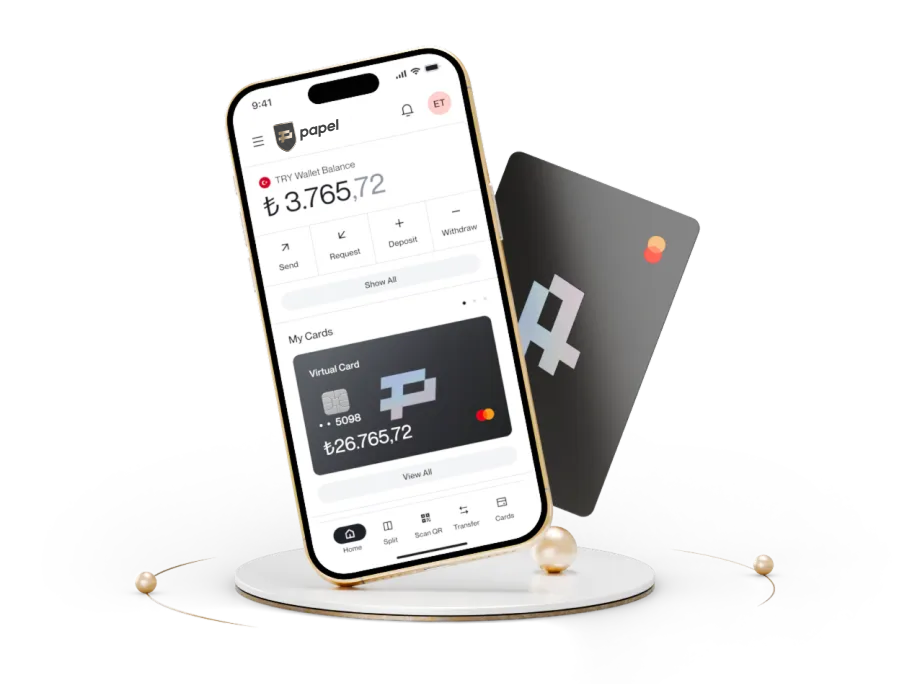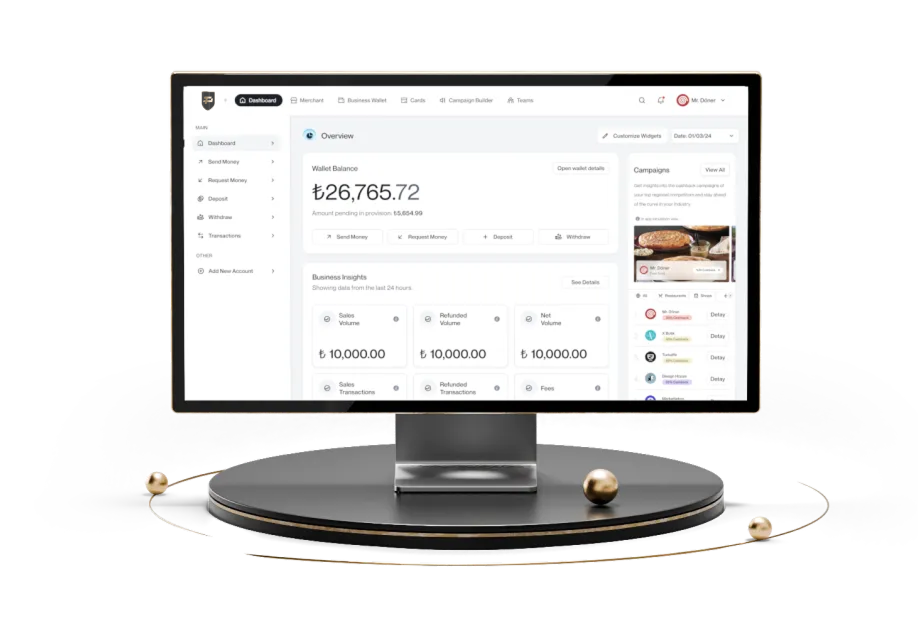What is International Money Transfer, and How is it Done?
In today's world, where global mobility is increasing, the movement of money is expanding, and the speed of transactions is accelerating. Systems and organizations allowing money transfers between countries are becoming more popular daily.
What is international money transfer? How is it done step by step? What are the fees associated with international money transfers? All these questions and more are answered on the Papel Blog…
What is International Money Transfer?
International money transfer (also known as remittance) refers to individuals living in one country or companies operating in one country sending money to another. Multiple methods are available for performing international money transfers, including bank-to-bank transfers, transfers from banks to physical money delivery points, or transfers from one physical delivery point to another in a different country.
Why Make International Money Transfers?
There are many reasons for making international money transfers. Individuals or organizations may want to send money abroad for specific needs. Individual senders often perform international money transfers to support their relatives living abroad or to cover the expenses of family members studying overseas.
On the other hand, organizations typically transfer money abroad for commercial reasons. These reasons can include paying for purchased goods or services, sourcing raw materials, or covering the urgent expenses of personnel sent abroad. Regardless of the cause, international money transfers make life easier for both individuals and organizations and are particularly beneficial for covering expenses that arise in emergencies.

How to Make an International Money Transfer?
It would be best to work with a bank or authorized financial institution to make an international money transfer. If you send money to an IBAN, you must first open an account with one of these institutions. For one-time transfers, completing the transaction without opening an account is possible. Depending on the methods provided by the institution, you choose the transfer method, enter the recipient's information, pay the necessary fees and taxes, and complete the international money transfer.
Step-by-Step International Money Transfer
The steps to follow for making an international money transfer are pretty simple:
- Register/Login
- Select Transfer Method
- Recipient Information
- Payment of Fees and Confirmation
- Receipt of Funds
Register/Login You can create a new account or log into your existing account with the financial institution to which you will arrange the payment. If you are creating a new account, you may need to verify your identity.
Select Transfer Method This step determines how the recipient will receive the payment. To proceed with the transaction, decide one of the international money transfer methods offered by the institution you work with.
Recipient Information You need to enter the recipient's information. If you send money to an overseas bank account, correctly enter the recipient's IBAN and SWIFT code. If the money is to be received from a physical money delivery point, you must accurately enter the recipient's address and identification details. SWIFT codes can vary depending on the country and bank.
Payment of Fees and Confirmation This step involves paying the fees and applicable taxes for the international money transfer. Fees can vary from one institution to another. However, each institution provides its customers with a transaction summary that includes the fees and taxes to be paid for this transaction. While reviewing the summary, pay attention to the accuracy of the recipient's information and the amount deducted from your account and received by the recipient. After checking all the details, you can start the money transfer process by giving your confirmation.
Receipt of Funds This step concerns the recipient. Once the money transfer is completed, communication between the sender's and recipient's payment service providers begins. The money is credited to the recipient's account when both parties approve the transaction. If the money is sent to a bank account, the recipient can access the funds without visiting a branch via mobile banking, internet banking, a bank card, or an ATM.
If the money is to be received physically from a delivery point, the recipient must go to that branch and collect the cash in person. At this stage, the recipient may be required to present a transaction reference code and an official identification document.
What is a SWIFT Code? Where Can You Find It?
SWIFT, an acronym for the Society for Worldwide Interbank Financial Telecommunication, is a unique identification code banks use to process international money transfers. The SWIFT code (also known as the BIC) ensures that money sent from one country accurately reaches the recipient's account in another country.
The structure of a SWIFT code can be described as follows:
Institution Code: Comprises the first four letters of the SWIFT code and represents the financial institution where the recipient holds their account.
Country Code: The following two letters (5th and 6th positions) indicate the country where the recipient’s account is held. For Turkey, this code is “TR.”
Location Code: The 7th and 8th characters specify the location of the institution's head office within the country.
Branch Code: The last three characters represent the specific branch where the recipient’s account is held. If it’s the head office branch, this part might be denoted as “XXX.”
Different Methods of International Money Transfer
The methods for international money transfers can vary depending on the financial institution you are using. Additionally, the decisions made by the regulatory bodies overseeing the banking sector in different countries can significantly determine the methods available for sending money from one country to another.
Traditionally, when considering the transfer of money from one country to another, the following methods can be mentioned:
Bank-to-Bank Transfer In this method, money is directly transferred from the sender’s bank or digital wallet account to the recipient’s bank account. It is considered one of the most convenient methods for international money transfers. Both the sender and the recipient can complete the transfer with minimal hassle. Many banks today allow this transaction to be carried out via the Internet or phone banking. The recipient can withdraw the money from an ATM closest to them or use it via internet banking.
Transfer via Physical Money Delivery Companies This method can be a bit more cumbersome compared to bank account transfers. In physical delivery, the sender, the recipient, or both must set aside time to physically visit the branch of the chosen institution to complete the transfer. The sender can send money from a branch or online via their bank account. However, the recipient must visit the physical branch of the institution to collect the money.
Methods Introduced by New Technologies In addition to the traditional international money transfer methods mentioned above, some methods have emerged due to new technologies. These include international transfers via bank/credit cards and international electronic money transfers between digital wallets.
For more detailed information and to explore the legal regulations related to international money transfers, click here.

International Money Transfer Fees
The fees applied for sending money abroad can vary depending on the fee policy of the institution you are working with. Some institutions charge a fixed fee for each transaction, while others prefer to apply a commission based on the transaction amount.
International Money Transfer Security
Banks' and international organizations' security systems ensure the security of international money transfers. To achieve total security, both the sender and the recipient have specific responsibilities. The sender should ensure they have correctly entered the recipient's information and transaction details and be careful not to share this information with third parties. The recipient should provide their information accurately to the sender and maintain the confidentiality of sensitive documents such as reference codes and transaction receipts.
Anti-Money Laundering (AML)
An essential aspect of international money transfers is the prevention of money laundering. Known as Anti Money Laundering (AML), this process is meticulously monitored by the institutions and organizations where the transaction is conducted. Financial institutions monitor transactions in real-time to detect suspicious activities and report them to the authorities. Advanced technologies and artificial intelligence can be used in these monitoring and reporting stages.
Frequently Asked Questions About International Money Transfers
How long does it take to send money abroad? The duration of international money transfer transactions can vary depending on the country and the infrastructure used by the institutions. The amount of money sent and the regulations of the countries also affect this duration.
How much money can I send abroad? Transaction limits for international money transfers can vary depending on the country and the method of sending the money (physical, IBAN transfer, etc.). Transfers made via SWIFT generally have higher limits. The industry tends to follow these approximate amounts when sending money from Turkey to another country:
- Euro: €10,000
- US Dollar: $10,000
- Turkish Lira: ₺100,000
What is the cheapest international money transfer method? The answer to this question can vary from institution to institution. Some institutions offer completely free services during promotional periods, while others may charge a fixed fee per transaction or a commission based on the transaction amount.
What should I pay attention to when sending money abroad? You should ensure that the amount and recipient information are entered correctly and completely. It is also advisable to be mindful of exchange rates. When sending money to physical delivery points, you may be given a reference number, which you need to convey to the recipient. Information related to the transaction should be kept confidential between the sender and recipient. Be careful to maintain the confidentiality of details like receipts and reference numbers.
What are international money transfer commissions? Commission rates can vary depending on the financial institutions where the transaction is conducted. Some institutions charge a commission based on the transaction amount, while others operate on a fixed fee policy.

